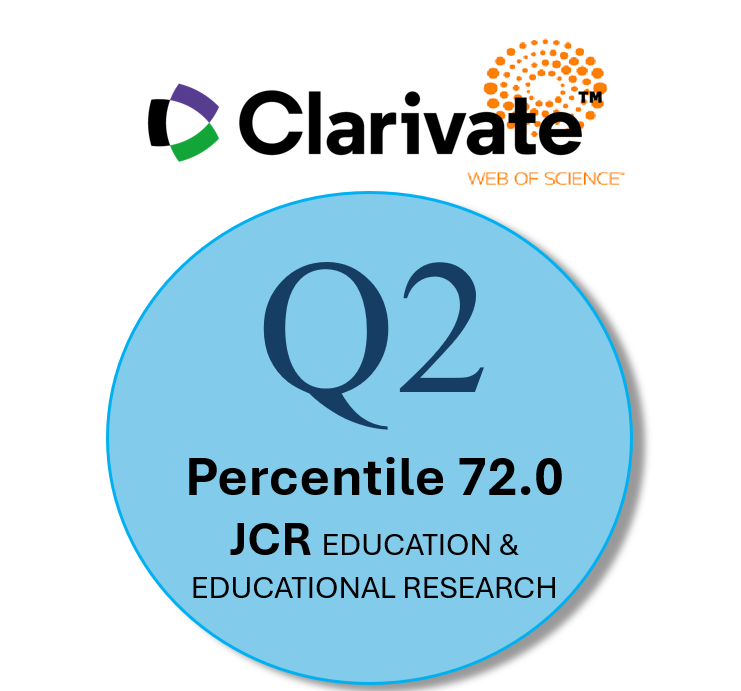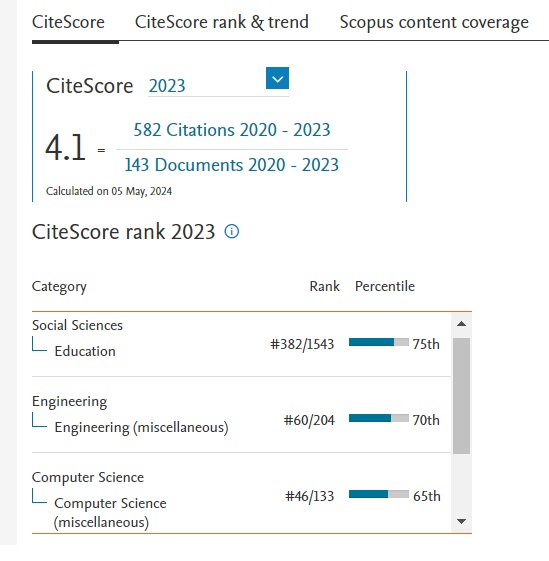Tabla DK eLearning: optimización de la práctica docente en un ambiente online
Resumen
El presente trabajo es el resultado del estudio realizado en el ámbito de la práctica pedagógica en la enseñanza superior en e-learning. Observamos una mejora cualitativa y necesaria de las prácticas docentes online en sus modelos pedagógicos. El panorama teórico general en la educación enfatiza la necesidad de reforzar y perfeccionar las estructuras didácticas de la enseñanza online, pero existe una escasez de instrumentos de transposición didáctica para que eso suceda. En este escenario y con el objetivo de traer una contribución para el relleno de esa laguna, proponemos a través de elementos didáctico-pedagógicos y tecnológicos en contextos online, una tabla de observación con base al modelo de Amador et al. (2016)
Los procedimientos metodológicos fueron soportados por referencias bibliográficas, reflexiones y discusiones que acompañaron las diversas fases del estudio de la creación y validación de la tabla, Presentamos un ejemplo aplicado en el área de la lengua y cultura española y proponemos una estructura teórica como apoyo al desarrollo y sus resultados.
Descargas
-
Resumen1237
-
ferreira_et_al753
Citas
Amador, F., Nobre, A., Barros, D. (2016a). "Towards a model of a didactic of eLearning: an application to education for sustainable development", Handbook of Research on Engaging Digital Natives in Higher Education Settings, IGI GLOBAL. DOI: 10.4018/978-1-5225-0039-1.ch019.
Amador, F.; Nobre, A.; Barros, D. ;Albuquerque, L. G.- A transposição didática no ámbito do eLearning In. DIas,P.:Moreira,D.:;Quintas-Mendes,A. (2016) Práticas e Cenários de Inovação em Educação Online. Universidade Aberta,Lisboa, Portugal, ISBN 9789726747864
Anastasi, A. Urbina, B. S. (2000). Testagem psicológica. Porto Alegre: ArtMed.
Anderson, T. (2005). Distance learning – Social software’s killer ap? 17th Biennial Conference of the Open and Distance Learning Association of Australia (ODLAA).
Anderson, T. ( 2008) Theory and Practice of Online Leanring, 2ª ed. AU Press, Athabasca University.
Aretio, L. G., Corbella, M. R., Figaredo, D. D. (2007). De la educación a distancia a la educación virtual. Barcelona: Editorial Ariel.
AusubeL, D.P. ( 1968) Educational Psychology: A Cognitive View. New York, Holt, Rinehart and Winston.
Ausubel, D., Novak, J., Hanesian, H. (1978), Educational Psychology: A Cognitive View (2d Ed.), New York: Holt, Rinehart & Winston.
Bandura, A. (1987). Pensamiento y Acción: Fundamentos Sociales. Barcelona: Ediciones Martínez Roca.
Barbasán Ortuño, I. P. (2016). El error léxico en la interlengua de lenguas afines: italiano y español.
Bruner, J. (1960). The Process of Education. Cambridge. Harvard University Press.
Castells, M. (2004). A Galáxia da Internet: Reflexões sobre Internet, Negócios e Sociedade. Lisboa: Fundação Calouste Gulbenkian
Coutinho, C. P. (2011). TPACK : em busca de um referencial teórico para a formação de professores em Tecnologia Educativa. Revista Paidéi@, vol.2(n.4), 18.
Downes, S. (2007). e-Learning 2.0 in development. Brandon Hall Research Innovations in Learning Conference, San Jose, California. Áudio e slides disponíveis em http://www.downes.ca/presentation/149
Fachel, J. Camey, S. (2000). Avaliação psicométrica: a qualidade das medidas e o entendimento dos dados (pp. 158-170). In: J. A. Cunha e cols. Psicodiagnóstico. (v. 5, ed. rev.) Porto Alegre: Artmed.
Flores, L. D., Meléndez, C. F. (2017). Variación de la autonomía en el aprendizaje, en función de la gestión del conocimiento, para disminuir en los alumnos los efectos del aislamiento. Revista De Educación a Distancia (RED), (54).
Gagné, R. M. (1996a). Learning processes and instruction. Training Research Journal. 1(1),p17-28.
Gagné, R. M. Medsker, K. (1996). The conditions of learning: Training Applications. Fort Worth, TX: Harcourt Brace College Publishers.
García Salinas, J., Ferreira Cabrera, A., Morales Rios, S. (2012). Autonomía en el aprendizaje de lenguas extranjeras en contextos de enseñanza mediatizados por la tecnología. Onomázein, 1(25).
Garrison, D. Randy (1989). Understanding Distance Education - a framework for the future. Routledge: London and New York, p. 139.
Garrison, R. Anderson, T. (2003). eLearning in the 21st Century: A Framework for Research and Practice. London & New York: RoutledgeFalmer.
Kawulich, B. B. (2005). Participant observation as a data collection method. Forum: Qualitative Social Research [On-line journal]. v. 6, n. 2, art. 43.
Kostoulas, A., Stelma, J., Lee, W., & Onat-Stelma, Z. (2015). Intentional Dynamics in TESOL: An Ecological Perspective. Working Papers in TESOL and Applied Linguistics, 15.
Kumaravadivelu, B. (1994). The Postmethod Condition: (E)merging Strategies for Second/Foreign Language Teaching. TESOL Quarterly, 28(1), 27.
Kumaravadivelu, B. (2001). Toward a Postmethod Pedagogy. TESOL Quarterly, 35(4), 537–560.
Latiesa, M. (1996). Validez e fiabilidad de las observaciones sociologicas. Em F. M. Garcia, J. Ibáñez F. Alvira (1996). El analisis de la realidad social: métodos e técnicas de investigación. 2a ed. (pp. 335-364). Madri: Alianza.
Lave, J.; Wenger, E. (1991) Situated Learning: Legitimate peripheral participation. Cambridge: Cambridge University Press.
Lewis, M. (1993). The lexical approach: The state of ELT and the way forward. Hove, England. Language Teaching Publications.
Lewis, M. (1997). Implementing the lexical approach: Putting theory into practice. Hove, England. Language Teaching Publications.
Maneira, S., Gomes, M. J. (2016). Professores e TPACK: Uma revisão sistemática da literatura. In L. Miranda, P. Alves, C. Morais (Eds.), Livro de Atas do VII Congresso Mundial de Estilos de Aprendizagem (pp. 1345-1360). Bragança: Instituto Politécnico de Bragança.
Martín Martín, J. M. (2000). La lengua materna en el aprendizaje de una segunda lengua. Sevilla. Universidad de Sevilla.
Mishra, P., Koehler, M. J. (2006). Technological pedagogical content knowledge: A framework for teacher knowledge. Teachers college record, 108(6), 1017 - 1054. Papert, S. (1993). Children’s machine: Rethinking school in the age of the computer. New York: Basic Books.
Morais, C. ( 2005) Escalas de Medida, Estatística Descritiva e Inferência Estatística
Papert, S. M.(1980) Mindstorms: Children, Computers and Powerful Ideas, New York: Basic Books, 1980.
Pasquali, L. (1996). Teoria e métodos de medida em ciências do comportamento. Brasília: Laboratório de Pesquisa em Avaliação e Medida da Universidade de Brasília.
Pereira, A.; Quintas Mendes, A.; Morgado, L.; Amante, L.; Bidarra, J. (2007) Modelo Pedagógico Virtual da Universidade Aberta, Lisboa, Universidade Aberta.
Peris, E. M. (1998). El profesor de lenguas: papel y funciones. Conceptos clave en didáctica de la lengua y la literatura, 1998, págs. 87-100 (pp. 87–100). Institut de Ciències de l'Educació, ICE.
Peters, O ( 2001). Didática do ensino a distañcia: experiências e estágio da discussão numa visao internacional. Traduação Ilson Kayser. São leopoldo , Unisinos.
Piaget, J. (1969). Psychologie et pédagogie, Denoel, Paris, 264p
Reis, F. A. G. (1999). Avaliação do Desempenho e Identidade Profissional Docente. Dissertação de Mestrado em Educação. Faculdade de Psicologia e Ciências de Educação. Universidade do Porto.
Richards, J. C., Rodgers, T. S. (1986). Approaches and Methods in Language Teaching. Cambridge: Cambridge University Press.
Rosenberg, J. M., Koehler, M. J. (2015). Context and Technological Pedagogical Content Knowledge (TPACK): A Systematic Review. Journal of Research on Technology in Education, 47(3), 186–210.
Rudestan,K.E; Read-Schoenholtz. J. (2010). Handbook of online Learning. SAGE: Unites Estates of American.
Saunders, M. N. K.; Lewis, P.; Thornhill, A. (2000). Research methods for business. Pearson: England.
Skinner, B. F.(1950) Are theories of learning necessary? The Psychological Review, 57, pp. 193- 216.
Tapscott, Don; Williams, Anthony D. ( 2010) The Prosumers. In: Wikinomics: how mass collaboration changes everything. New York, USA: Penguin Books,
Vieira, F. Moreira, M.A. (2011).Supervisão e avaliação do desempenho docente. Para uma abordagem de orientação transformadora. Conselho científico para a avaliação de professores. Ministério da educação
Vygotsky, L. (1978). Interaction between learning and development.Readings on the development of children, 23(3), 34-41.
Wiebe, J. H., Taylor, H. G. (1997). What should teachers know about technology? A revised look at the ISTE foundations. Journal of Computing in Teacher Education, 13(3), 5–9
Yin. R. K. (2005). Estudo de caso: planejamento e métodos. 3 ed., Porto Alegre: Bookman
Las obras que se publican en esta revista están sujetas a los siguientes términos:
1. El Servicio de Publicaciones de la Universidad de Murcia (la editorial) conserva los derechos patrimoniales (copyright) de las obras publicadas, y favorece y permite la reutilización de las mismas bajo la licencia de uso indicada en el punto 2.
2. Las obras se publican en la edición electrónica de la revista bajo una licencia Creative Commons Reconocimiento-NoComercial-SinObraDerivada 3.0 España (texto legal). Se pueden copiar, usar, difundir, transmitir y exponer públicamente, siempre que: i) se cite la autoría y la fuente original de su publicación (revista, editorial y URL de la obra); ii) no se usen para fines comerciales; iii) se mencione la existencia y especificaciones de esta licencia de uso.
3. Condiciones de auto-archivo. Se permite y se anima a los autores a difundir electrónicamente las versiones pre-print (versión antes de ser evaluada) y/o post-print (versión evaluada y aceptada para su publicación) de sus obras antes de su publicación, ya que favorece su circulación y difusión más temprana y con ello un posible aumento en su citación y alcance entre la comunidad académica. Color RoMEO: verde.














